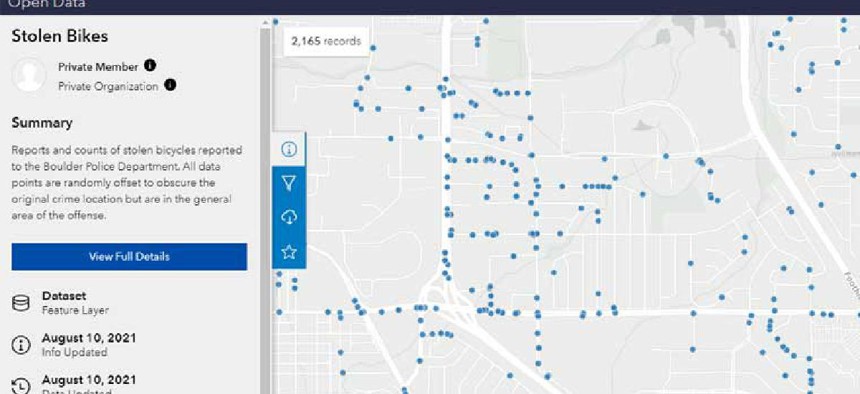How open data helps Boulder police, community tackle crime


Connecting state and local government leaders
The Boulder, Colo., Police Department’s new open data portal lets the public view and download crime data as part of an effort to boost transparency and reduce crime.
The Boulder, Colo., Police Department’s (BPD) new open data portal lets the public view and download crime data as part of an effort to boost transparency and reduce crime.
One of the portal’s main features is a dashboard, powered by Esri’s cloud-based ArcGIS Online, that lets users see the total offenses in the city, where and when they happened and how the number changed over time. Users can also filter by offense type, such as assault or theft, and search by neighborhoods or addresses. Additionally, they can download the data in a .csv format for use in Microsoft Excel, Apple Numbers or Google Sheets.
The tool builds on the city of Boulder’s Open Data Hub, which launched in 2016. It includes information on the environment, government operations and infrastructure. BPD added police offenses data on May 13, with the dashboard following soon afterward.
Boulder residents “can look at issues themselves and feel that they have some level of control and power over their decision-making and what they need to, which I think is so important in community collaboration,” Police Chief Maris Herold said. “We shouldn’t have all of the knowledge. The community should have just as much knowledge as we do.”
Each dataset is published as a feature layer, allowing it to be presented in tabular and map formats. Data is added daily via a script that pulls it from BPD’s records management system, formats it and pushes it to ArcGIS Online. The script is set to pull data dated from Jan. 1, 2019, to two days before the run-time to allow for corrections to or validations of report records. The script also anonymizes address to the nearest block to protect victims’ identities.
Coming next month is a similar dashboard for internal use that’s being developed in-house with Zidar Analytics. That dashboard will support tactical and strategic analyses to let officers see where additional resources, such as more frequent patrols, are needed, Herold said. The dashboard will also contain personnel data so the chief make informed decisions about staffing.
“It allows the executive team and the command staff to really start problem-solving … and actually reduce those crimes that have been plaguing the city,” she said.
One of those long-term problems is bike theft. Of the city’s almost 5,400 street segments, 84% have zero bike thefts, according to a June BPD presentation to the Boulder City Council, but 4.5% of segments have had at least three bike thefts and account for 65.6% of that crime. By being able to see where that particular crime happens often, people can better plan their trip, whether that means bringing a bike lock or taking another form of transportation.
Additionally, BPD recommended that the city better light high-traffic biking areas, distribute theft prevention information and encourage residents to register their bikes through the Bike Index, a nonprofit bike registry. The effort has resulted in a 30% decrease in bike theft in 2021, compared to 2020, according to the department.
“Similar types of crime cluster together,” so it is important to cut off crimes of opportunity, Herold said. “That’s what I’m trying to get the community to understand. They can prevent a lot of this crime.”
To raise awareness about the open data portal, BPD has conducted focus groups, community forums and community dialogue meetings in addition to providing presentations to City Council.
The response has been positive, Herold said. “I get a lot of emails asking for additions to the community dashboards,” she said. “I know people are in there and playing with it.” Those additions include more datasets and fields, which are in the works.
The idea for the portal came from Herold’s goal to help police executives make data-based decisions. “This was part of my early police-reform package … being transparent with our datasets and to provide the community with the same datasets that the police officers were seeing on a daily basis,” she said. “If the community is going to help me solve and prevent crime, they have to know about it and they have to have as close as possible to real-time data.”
Overall, the city envisions a technology platform that can show all of the city’s data. As policing evolves, the scope and depth of the city’s data must grow as well, Herold said. “Other city departments in the community have a major role to play in addressing chronic crime and disorder issues, and I think we’re getting closer to that -- and I’m excited about that.”




